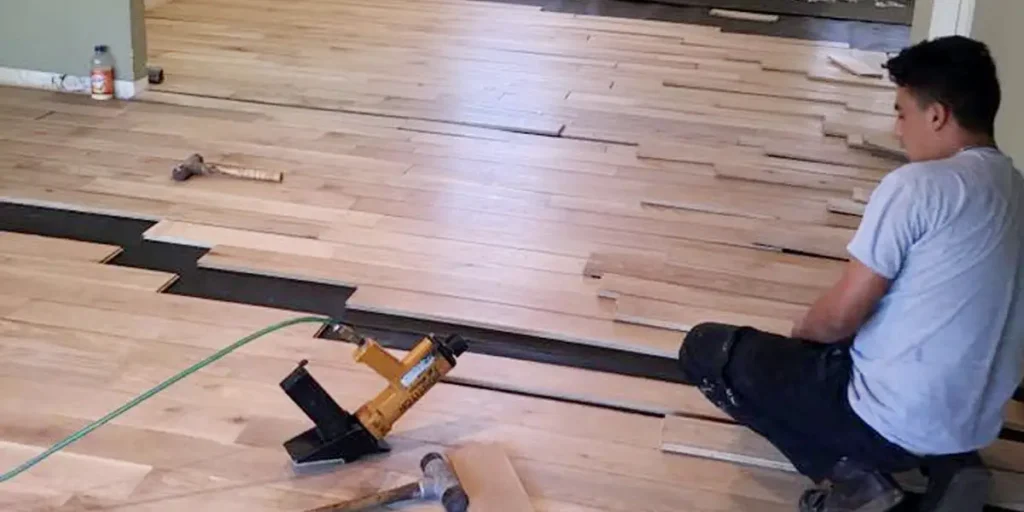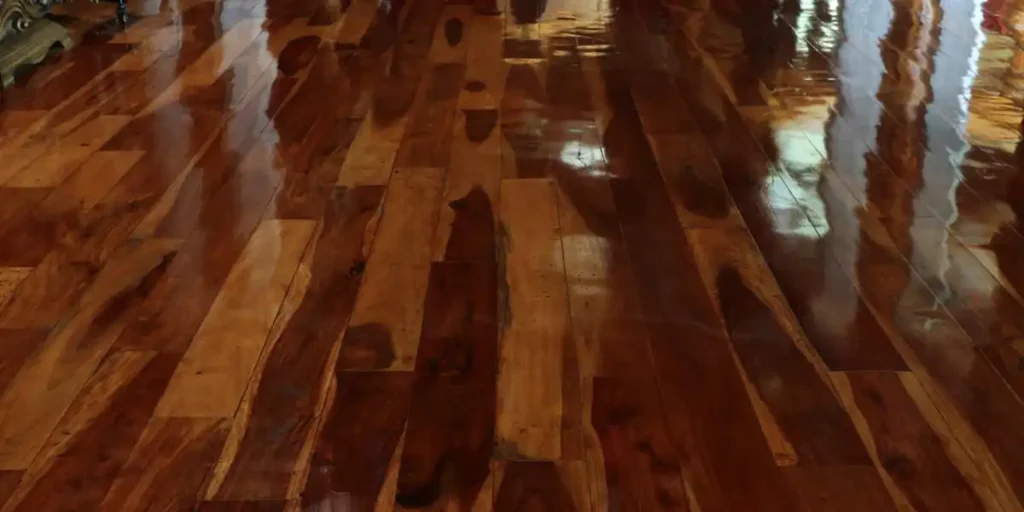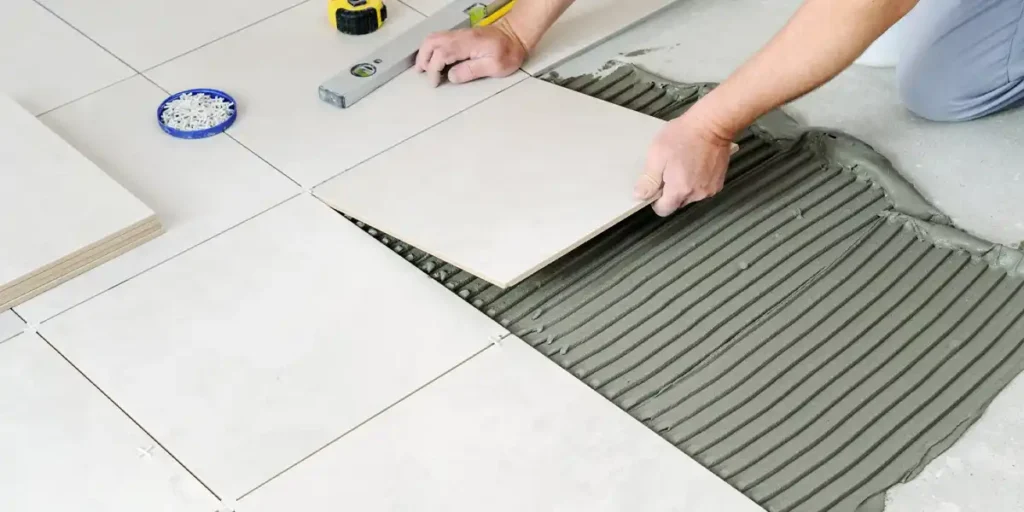You’re dreaming of replacing your cold, hard tiles with the warmth of wood flooring. The idea of removing the existing tile seems daunting expensive, messy, and time-consuming.
But is it possible to lay wood flooring over tile? The answer: Yes, but it’s not always straightforward.
In this guide, we’ll explore the challenges, solutions, and best practices to help you make an informed decision and achieve the floors of your dreams.
Understanding the Challenges of Laying Wood Flooring Over Tile
While laying wood flooring over tile is feasible, it comes with unique challenges that need addressing:
- Uneven Surfaces:
Tile floors often have uneven surfaces, with grout lines creating dips. Without correction, these can cause squeaking or buckling in the wood flooring above. - Adhesion Issues:
Tile’s smooth, glossy finish can make it difficult for adhesives to properly bond. Specialized adhesives or underlayments are often required. - Added Height:
Installing wood over tile increases the floor’s height, potentially impacting door clearance, baseboards, and transitions between rooms. - Subfloor Integrity:
If the subfloor beneath the tile is damaged or unstable, issues will eventually surface in your new wood floor. Assessing the subfloor is critical.
Solutions That Work: Overcoming the Hurdles
Despite the challenges, there are proven solutions to successfully lay wood flooring over tile.
Preparation is Key: Assessing the Existing Tile Floor
- Inspect tiles for cracks or looseness. Replace or repair damaged areas.
- Check for uneven grout lines or tile height differences. These must be leveled.
Leveling the Surface
- Use a self-leveling compound to fill grout lines and create a flat surface.
- If the tile surface is severely uneven, consider professional help.
Choosing the Right Wood Flooring
- Engineered Wood: Best for this application, engineered wood is more stable and less prone to moisture damage than solid hardwood.
- Floating Floors: Options like laminate or engineered click-lock wood can be installed over tile without adhesives, making them a versatile choice.
Using the Right Adhesive
- Select an adhesive specifically designed for bonding wood to tile. These adhesives provide the necessary grip for a secure installation.
Moisture Considerations
- Always use a moisture barrier underlayment to prevent issues caused by moisture trapped between the tile and wood.
The Installation Process: A Step-by-Step Guide
Transforming your tiled space with wood flooring requires careful planning and execution. Follow these detailed steps to ensure a smooth and professional-looking installation.
Step 1: Clean and Prep
Begin by thoroughly cleaning the tile surface. Remove all dirt, grease, and debris to ensure the adhesive bonds effectively. Use a strong degreaser if needed, and vacuum or sweep the area to eliminate dust. A clean surface is the foundation of a successful installation.
Step 2: Repair and Level
Inspect the tile for cracks or loose tiles. Repair these with tile adhesive or grout to create a stable base. Uneven surfaces can cause wood planks to shift or squeak, so use a self-leveling compound to smooth out any high or low spots. Allow the compound to dry completely before proceeding.
Step 3: Lay Underlayment
Depending on your wood flooring choice, you may need to install an underlayment. A moisture barrier is essential in areas prone to humidity or spills, such as kitchens or basements. Foam underlayment can also provide cushioning and soundproofing, improving the overall performance of your wood floor.
Step 4: Apply Adhesive
For glue-down installations, evenly spread adhesive using a notched trowel. Work in small sections to prevent the adhesive from drying out before the planks are laid. Follow the manufacturer’s instructions for the adhesive to ensure proper bonding.
Step 5: Install Wood Flooring
Start in one corner of the room and work your way outward. For click-lock planks, align and lock them into place using the recommended tools. For glue-down planks, press each plank firmly into the adhesive, ensuring tight seams for a seamless look.
Step 6: Finishing Touches
Trim door frames to accommodate the new flooring height. Reinstall or adjust baseboards for a snug fit. Add transition strips where the wood flooring meets other flooring types, creating a polished and cohesive finish.
By following these steps, you can achieve a flawless wood flooring installation over tile, enhancing the beauty and functionality of your space.
Final Thoughts
Laying wood flooring over tile is a practical solution for transforming your space without the hassle of tile removal. With proper preparation, the right materials, and careful installation, you can achieve a beautiful, durable wood floor.
Whether you opt for engineered wood, floating floors, or glued planks, addressing the challenges upfront ensures a long-lasting result. For complex projects, consulting a professional is always a wise choice. Transform your home and enjoy the warmth and elegance of wood flooring today!
If you need assistance with tiling or flooring installation, Cardenas Flooring is your go-to partner in Texas. Contact us today to book your required service.
FAQs
Can I lay wood flooring over tile without removing the tile first?
Yes, you can lay wood flooring over tile without removing it, provided the tile is in good condition. Inspect the tile for cracks or looseness, and ensure the surface is level. Use a self-leveling compound if needed. Engineered wood or floating floors are better suited for this process than solid hardwood, which is more sensitive to uneven surfaces and moisture issues.
What type of wood flooring is best for installation over tile?
Engineered wood and laminate flooring are ideal for installation over tile. Engineered wood is stable and moisture-resistant, making it less prone to warping. Laminate is lightweight, cost-effective, and easy to install using a floating method. Avoid solid hardwood, as it requires a stable, perfectly level base and is more susceptible to damage from underlying tile imperfections.
Will adding wood flooring over tile raise the floor height significantly?
Yes, installing wood flooring over tile will raise the floor height, typically by ½ to 1 inch, depending on the wood and underlayment used. This might require adjustments to doors, baseboards, and transitions to other rooms. Plan for these changes before installation to ensure seamless transitions and proper functionality.
How do I prepare tile flooring for wood installation?
Start by cleaning the tile thoroughly to remove dirt and grease. Repair any cracks or loose tiles and fill grout lines with a self-leveling compound for a flat surface. For glued wood floors, use a suitable adhesive for tile. For floating floors, ensure the tile surface is smooth and add an underlayment for cushioning and moisture protection.
Does laying wood flooring over tile affect durability?
Durability depends on preparation and the flooring type. Engineered wood and laminate are stable and durable when installed over tile, provided the base is properly prepared. Poor preparation, like uneven surfaces or moisture issues, can lead to premature wear, squeaking, or damage, compromising the floor’s longevity. Proper planning ensures long-term success.




